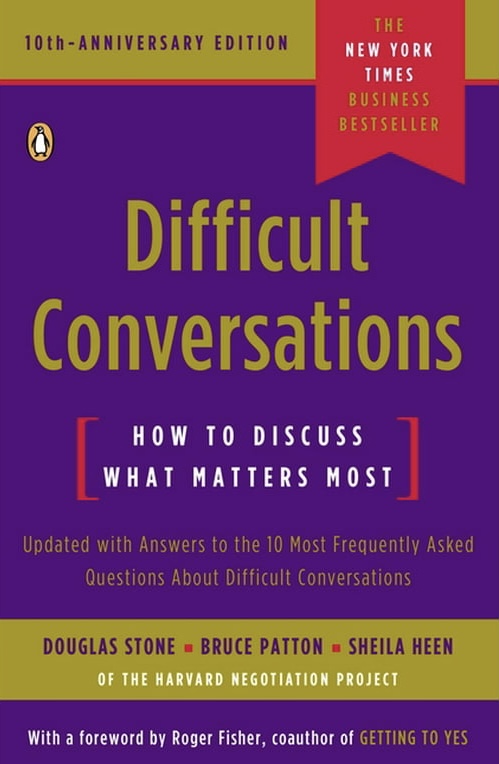Difficult Conversations provides invaluable advice on expertly navigating conflict by breaking down the conversation into three distinct components. The “what happened” conversation focuses on understanding intent on both sides, not convincing anyone of your perceived truth. The “feelings” conversation reveals what you and others are feeling, if it is valid, and what’s being shared vs hidden. The “identity” conversation reveals what the situation means to us and how it’s impacting our own and other’s perception of who we are as a person. Effective teams thrive because of the differences amongst their members. This strength turns into a weakness, however, without the ability to be receptive and inclusive to a broad range of perspectives, especially those that do not agree with your own. The skills and methods from this book can thus empower healthy debate and better decision making across a diverse team. I deeply admire leaders who can gracefully navigate contested topics and difficult personalities, and this books helps unlock their effective techniques.
You should read this book if you…
- want to be a more honest and empathetic leader
- are open to understanding your shortcomings to handling difficult conversations
- have a hard time interacting with certain people
Favorite Quote
“The error in intentions is simple but profound: we assume we know the intention of others when we don’t, and when we are unsure, we often decide they are bad“
Additional Information
Year Published: 1999
Book Ranking (from 1-10): 8 – Very Good – In depth insights on a specific topic
Ease of Read (from 1-5): 3 – Average
Key Highlights
- Sort out three conversations: a) what happened, b) feelings, c) identity
- The point of a difficult conversation is almost never about getting the facts right, it’s about conflicting perceptions and interpretations
- What happened: move away from a “truth” by shifting the purpose of trying to prove we’re right to understanding the perceptions and interpretations of the other side
- The error in intentions is simple but profound: we assume we know the intention of others when we don’t, and when we are unsure, we often decide they are bad
- Talking about blame distracts us from exploring why things went wrong and how we might correct them going forward
- Feelings are not a byproduct of a difficult conversation, they are an integral part of the conflict
- Telling someone to change makes it less likely that they will because most people never change without first feeling understood. We need to understand a person’s story well enough to see how their conclusions make sense and we need to help them understand how our story makes sense
- The only way to understand someone else’s story is to be curious. Certainty locks us out of their story, curiosity lets us in. The act of understanding someone else’s story doesn’t require you to give up you’re own
- While we care deeply about other’s intentions we don’t actually know what they are. We can’t because they are in the hearts and mind of the other person
- We often make the attribution about another person’s intentions based on the impact of their actions on us. We feel hurt so they intended to hurt us
- When we think others have bad intentions, it affects our behavior, which in turn affects how they treat us. Our assumptions of bad intentions come true
- When you share your assumption about the other’s intentions, be clear that you are making assumptions (guesses) to see if it makes sense to the other person
- Start by acknowledging their feelings and then return to the question of intentions – it will make your conversation easier and more constructive
- Map the contribution system – blame is about judging, contribution is about understanding. What you want the other person to say isn’t “It was my fault,” but rather “I understand that I hurt you and I’m sorry.” The first statement is about judgment, the second about understanding
- Sometimes we lose our temper not because we share our feelings too often but too little
- While they may feel similar, there is a vast difference between “You are thoughtless and self- absorbed” and “I feel hurt, confused, and embarrassed.” Finding the feelings that are lurking around and under angry attributions and judgments is a key step in bringing feelings into a conversation effectively
- Next, we need to explore our assumptions about the other person’s intentions. To what extent are our feelings based on an untested assumption about their intentions?
- Finally, we should consider the contribution system. Are we able to see our own contribution to the problem? Are we able to describe the other person’s contribution without blaming?
- Each side must have their feelings acknowledged before you can even start down that road. Acknowledgment is a step that simply cannot be skipped. What does it mean to acknowledge someone’s feelings? It means letting the other person know that what they have said has made an impression on you, that their feelings matter to you, and that you are working to understand them
- One reason people are reluctant to admit mistakes is that they fear being seen as weak or incompetent. Yet often, generally competent people who take the possibility of mistakes in stride are seen as confident, secure, and “big enough” not to have to be perfect, whereas those who resist acknowledging even the possibility of a mistake are seen as insecure and lacking confidence. No one is fooled
- Four things you can do before and during a difficult conversation to help yourself maintain and regain your balance include: letting go of trying to control their reaction, preparing for their response, imagining the future to gain perspective, and if you lose your balance, taking a break
- The gold standard of a learning conversation is mutual understanding (not mutual agreement)
- Importantly, you don’t have to know what the other person’s story entails to include it in initiating the conversation this way. All you have to do is acknowledge that it’s there: that there are probably lots of things you don’t understand about their perspective, and that one of the reasons you want to talk is that you want to learn more about their view. You can begin from the Third Story by saying, “My sense is that you and I see this situation differently. I’d like to share how I’m seeing it, and learn more about how you’re seeing it.”
- If you notice that the other person is saying the same thing over and over again, take it as a signal that you need to paraphrase more. Once they feel heard, they are significantly more likely to listen to you
- Say What Would Persuade You. Being open to persuasion is a powerful stance to have. It allows you to be honest and firm about your current views, and to listen to theirs

Discover more from The Broader Application
Subscribe to get the latest posts sent to your email.
